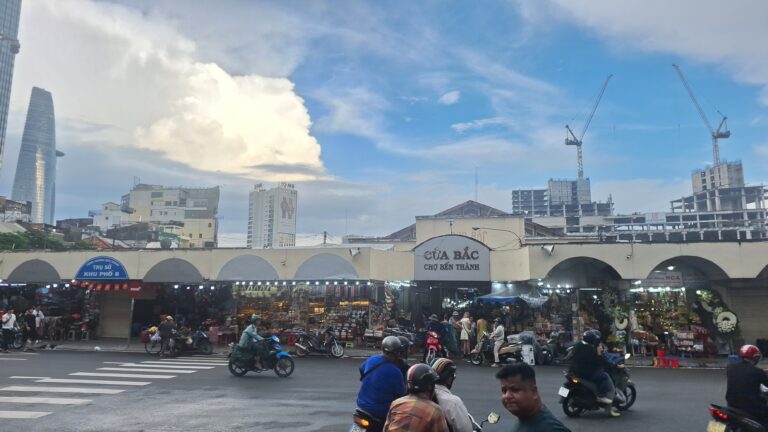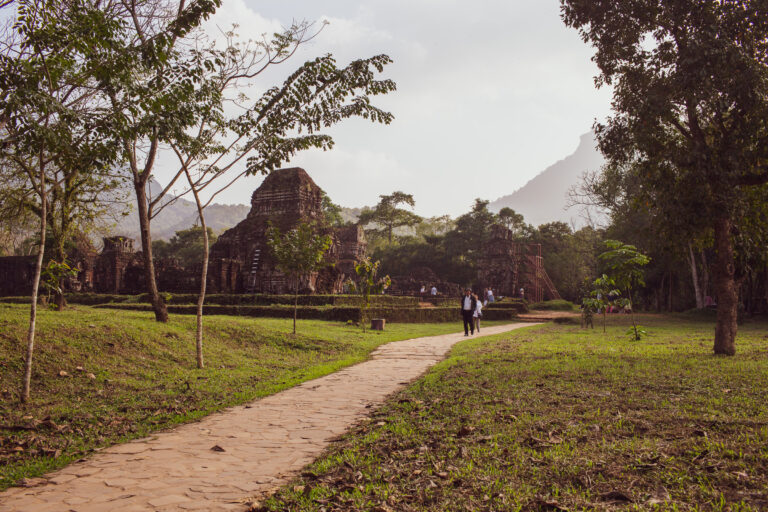
Home > Blog > Motorcycles > Buying a Motorcycle in Vietnam – What You Need to Know About
Buying a Motorcycle in Vietnam – What You Need to Know About
Share:
- Published:
- Updated: 20/01/25

One of the best ways to see Vietnam is by motorcycle. Taking to the mountains, plains, forests, and coastal paths of this country on two-wheels offers the sort of experience you won’t find on a regular vacation. So book a flight, buy a bike, and let’s go!
If only it were that easy. Before we get into the nitty-gritty of what you need to know about buying a motorcycle in Vietnam, let’s look at the overall picture of motorcycle purchase in the Indochina peninsula.
Table of Contents
Buying a Motorcycle in Vietnam
For half of Vietnam’s population, two-wheelers are the only transport option. They account for a staggering 45 million motorcycles on the streets. Unfortunately, in technical terms, the vast majority of these bikes are entirely goosed. This results in many having to turn to backstreet mechanics. Here, they bring them back from the dead. Thus, they continue to belch their pollution-filled exhaust fumes for yet another day.
This is, of course, is not something to be ignored. Although the potential ban on motorcycles from the two largest cities by 2030 could bring with it mobility challenges. The government has proposed a raft of measures for greener public transport systems
In the meantime, other cities have introduced legislation making it slightly easier for buying a new motorcycle in Vietnam. This legislation has all the makings of a win-win situation. It will give more people the chance of owning a new bike. At the same time cut pollution by reducing the number of smoke-belching basket cases on the streets.
Cash is King
Cash will always be king when it comes to the man in the street. However, with the average new, good quality, small capacity, commuter motorcycle costing around VND 35milion (approximately 1600 US$) more people are forced to take out personal loans.
According to the Czech-backed financial company Home Credit Vietnam, the first six months of 2019 has seen motorcycle buying loans rise by more than 50%. Figures reveal a male to female customer ratio of 60/40.
Taking advantage of any new two-wheel enthusiasm, the company is currently trying to convince more of its 1,100 retailer partners to offer 0% finance deals throughout their 1800 nationwide outlets.
Buying a Motorcycle in Vietnam: Options for Non-Residents
So if Vietnamese citizens are openly encouraged to hit the buy-it-now button, what’s the deal for non-residents? This question has a black, a white, and 50 shades of grey answer. This just depends on just how legal you are hoping to be.
Let’s start with those bright-eyed, bushy-tailed optimists; the two-wheeled backpackers who will pay crazy money for something that looks like it won’t start without the help of a defibrillator.
So, if like them you can’t wait to start your adventure, check out the ‘for sale’ cards. You will find them in student-friendly hostels, online backpacker classified ads and Facebook pages. The various makes and models of small-bore step-thru are too numerous to mention. Include highly coveted genuine Japanese models, innumerable mutations, plus hybrid look-alikes.
Just bear in mind though, before you overpay, this type of bike is likely to have clocked-up anything from 500–2000 km of hard riding in the last week alone. It is also probably crying out for service. Expect to pay between $200 (for something that looks as if it’s been to hell and back) rising to $500 for a bike that may even get you there and back, eventually.
Savvy backpackers, who tend not to buy from shops, often arrange for a local spanner man to check out any potential motorcycle purchase. Parts are plentiful, and labour is cheap, so this is an inexpensive and safe way to go about doing this.
You can also check out the local neighbourhood mechanics for bikes for sale. Even if they haven’t got any themselves, they’ll probably know a local who has. You may pay a few bucks more, but theoretically, you should be ready to rock.
Buying a Motorcycle in Vietnam: Documentation
Even though the potential for buying a complete mutt is relatively high, this route for lots of people is considered to be the path of least resistance. Theoretically, all you need is the previous owner’s documentation (the blue card). And an international driving license along with a Vietnamese translation.
Be aware though, that you are now flying by the seat of your pants. Having a blue card isn’t strictly proof of ownership. As by law, the document has to be transferred into your name. If you don’t check out documents details against the bike, you could also be left with a blue card. This can’t be transferred because the numbers don’t match the bike. The fact that many people may choose to ignore this doesn’t make it right. Injure yourself or someone else or damage another vehicle or property in an accident under these circumstances and all the fancy travel insurance policies in the world are rendered worthless.
Taking a Gamble
Also, a lot of small garages are not licensed sellers, merely authorised repairers. Remember, the promise of a warranty from one of these guys is a gamble; they may do the right thing or suddenly develop amnesia.
A foreigner can only legally buy a motorcycle in Vietnam if they hold a resident permit. A temporary one is good for up to three years and needs proof of address and full- time employment. A permanent card, on the other hand, requires you to show how you will earn a living while in the country. This also demands you demonstrate a working knowledge of the language.
Many tourists decide to take a chance and purchase a bike without having the permit or even a legally recognise license to ride. Before taking such a risk, be aware that there are serious risks involving in riding illegally. For a clear and detailed explanation of the chances you are taking you should read the relevant section of this article.
Motorcycle Licenses
Currently, there are two types of motorcycle license in operation; A1 and A2. The first covers you up to 175cc and the latter goes from 175cc to unlimited. These two engine sizes, together with an insane import duty on big bore foreign motorcycles, pretty much dictates the type of machines that are available to buy.
Of the 45m bikes on the road, it’s safe to say that around 98% will fall into the chicken chaser, A1 category and in reality; the average engine capacity is probably around 70-125cc.
That may be about to change. Even if it is by a minimal amount, as big brand, large capacity imported motorcycles are now on the showroom floor. Don’t get too excited just yet; the price in Vietnamese terms is still astronomical due to the import duty. The fact that they allow these into the country legally though is a good omen for the further relaxing of import duties.
To avoid the tax burden and remain competitive, some of the big names including Yamaha, Honda, Suzuki, Piaggio, and SYM, have opened Vietnamese production plants. An expensive way to keep the price down. Perhaps, until you consider that Vietnam is the 4th largest motorcycle market in the world, buying over 3m bikes a year.
On the subject of prices, due to its familiarity and reputation as a repository of cheap two-wheel transport, you’d be forgiven for thinking Craigslist is a smart place to begin your search. Not so in Vietnam! It’s seen as a cat-fishing site for unscrupulous dealers to offload their junk to greenhorn backpackers.
From Bottom Feeder to Top Shelf
To give you an idea, here are a couple of examples from Craigslist Vietnam. The first is a seven-year-old Honda Solo which has the words’ Copy’ after it. In all probability, it’s a cheap clone. The owner proudly boasts that the Blue Card says 50cc engine. However, it has been ‘upgraded to 135cc’. All this and a pair of Z-bars for a mere 35 million VND (1500+ US$).
Alternatively, you could go for a real bargain bike. A 127cc Detech Espero of undetermined age and looking like it’s traversed the planet. All for the bargain price of 3 million VND (128 US$). The owner is also throwing in 20 bungee cords (probably need to keep the engine attached to the frame) and a rain poncho. Be quick, though, because it’s got no paperwork and the owner leaves at the end of the week!
If you’re in the market for more of a statement machine, head to the other end of the spectrum. Where Harley-Davidson Ho Chi Minh City offers a 2019 FXDR 114 for a mere 809,500,000 VND, $34,800. The same model is on sale in the US for $21,749 and you can forget about a free rain poncho.
Economy on the Rise
The fact that Harley Davidson has allowed franchisees to set up in three locations in Vietnam is a testament to an economy on the rise. And the reason why you’ll also find KTM, Ducati, Triumph, and BMW together with top Japanese manufacturers offering (albeit in small numbers) big bore roadsters.
With the height of Vietnamese males averaging out at 5’5” (women 5’1”), the likes of BMW’s gargantuan 1200 GS and the towering 1290 KTM Super Adventure, are quite literally out of reach. It hasn’t, however, prevented a slow but steady turn towards the popularity of dual sportbikes.
Heading-up the pack is Honda’s 125cc and 250cc CRF range, not surprisingly as the brand is Vietnam’s top seller. They are followed by Suzuki’s DRZ400, which is about to get some serious competition from Royal Enfield’s 400cc dual-sport Himalayan.
Dual Sports and Café Racers
The current passion for dirt bikes matches that of urban riders drawn towards the café racer look. Young Vietnamese bikers are now looking at their daily rides with fresh eyes. With most are starting to customise their small-bore bikes by cutting down the bodywork, fitting low bars, and painting everything matt black.
When you see the likes of Honda jumping on the retro bandwagon with the Asian-market-only CB150R’ Street Café’ and ‘Scrambler Café’ you know there’s a demand. Just like the Himalaya’s assault on the Asian buying public. Their range of retro street motorcycle is also sharing space in Vietnam showrooms. Triumph also has an equally strong line up of off-road and retro bikes.
Onyabike Adventures Suggests
So there we have it, an entire menu of options from rolling rats to top-shelf mega-bikes and loan friendly all-rounders. The choice, like the budget, is all yours. However, if I can offer one piece of real-world advice it is simply this. If you’re venturing out of town and into the scenic countryside of Vietnam, just make sure your bike’s got a kick-starter. Bump-start it on a rough track will put a serious crimp in your day.
Related Posts
Recent Posts






